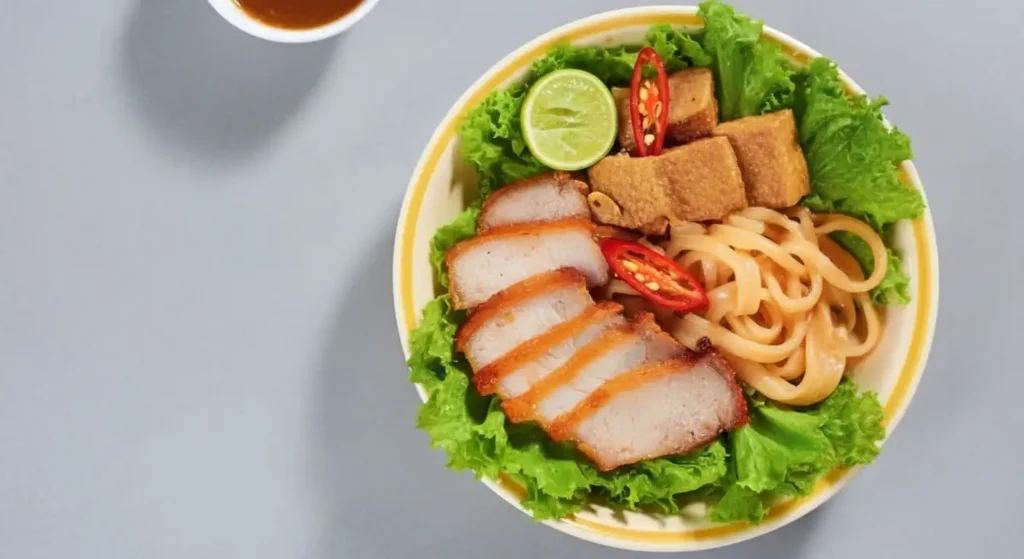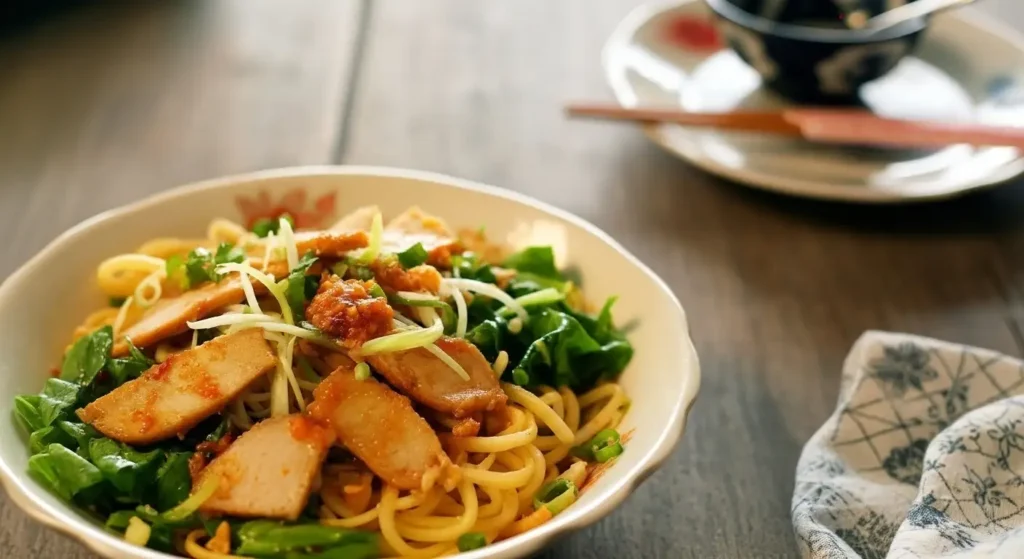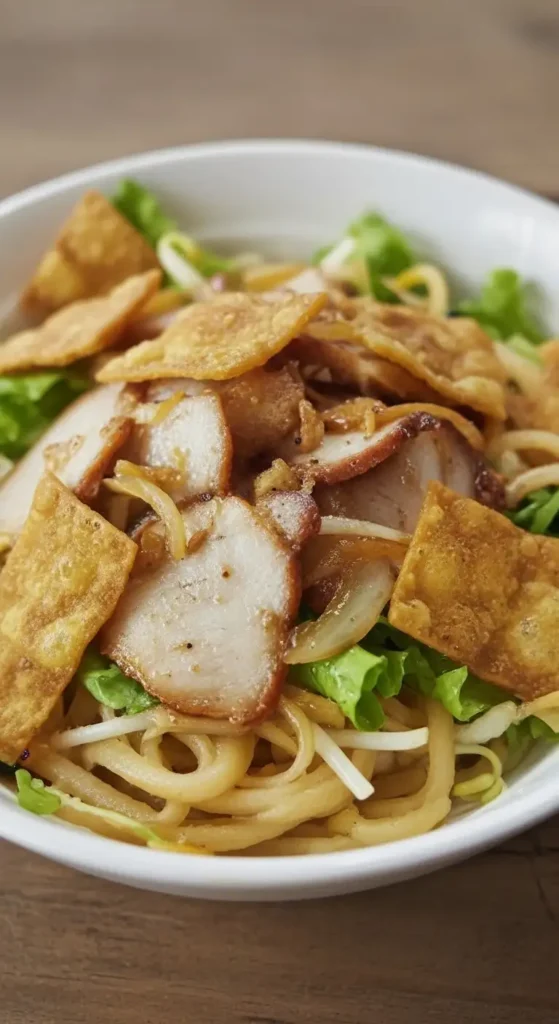Cao Lầu: The Basics
Cao Lầu (pronounced Kow Lao) is a dry noodle dish with a rich history, believed to be a fusion of Vietnamese, Chinese, and Japanese culinary influences stemming from Hoi An’s past as a bustling international trading port in the 17th century.
The Legendary Noodles: The centerpiece of the dish. Cao Lầu noodles are thick, chewy, and yellowish-brown. Local legend dictates that they must be made from rice that has been soaked in lye water (alkaline water) leached from the ashes of certain plants on the nearby Cham Islands, and that the water used for mixing and boiling must be sourced from the ancient Bá Lễ well in Hoi An. This specific, meticulous process is what gives the noodles their unique texture and color.
The Toppings: The meat is typically thinly sliced char siu-style pork (thịt xá xíu), marinated and cooked until tender and flavorful.
The Sauce (Broth): Similar to Mì Quảng, Cao Lầu is served with only a small, concentrated amount of savory liquid or sauce, not a full bowl of soup. This rich sauce is made from the pork marinade and pork stock.
The Crunch: The dish is often topped with crispy squares of fried rice paper or pork cracklings, providing a vital textural contrast.
The Greens: A generous bed of fresh local herbs, lettuce, and bean sprouts completes the dish.

Types of Cao Lầu
Cao Lầu does not have the wide array of protein-based variations seen in Mì Quảng. Its identity is tied to the unique preparation of its noodles and its classic toppings.
Cao Lầu Thịt Xá Xíu (Classic Cao Lầu): The standard and most traditional version, featuring the signature char siu pork.
Cao Lầu Chay (Vegetarian Cao Lầu): A meatless alternative that substitutes the pork with fried tofu or various mushrooms, maintaining the essential sauce and noodle texture.
Minor Topping Changes: Some street stalls might offer variations by adding sliced shrimp instead of or alongside the pork, but the core essence of the noodles and the rich, small amount of sauce remains consistent.

How to Eat Cao Lầu
Cao Lầu is fundamentally a “mixed” noodle dish, similar to a salad, meant to be savored for its combined textures and complex flavors.
Preparation: The bowl is typically layered with fresh herbs and bean sprouts at the bottom, topped with the Cao Lầu noodles, char siu pork, and a small ladle of the rich sauce, finished with crispy rice paper.
Mix Thoroughly: Before eating, use your chopsticks and spoon to mix all the components vigorously. Ensure the concentrated sauce and rich meat flavors coat every strand of the thick, chewy noodles.
Combine Textures: Take a bite that includes all the elements: the chewy, thick noodle, the tender pork, the fresh crunch of the herbs and bean sprouts, and a piece of the crispy fried rice paper.
Add Condiments: Condiments like fresh chili paste, sliced chili, and sometimes a wedge of lime are available on the side. Adjust the spice and acidity to your personal taste.

Regional Differences
The most critical factor distinguishing Cao Lầu is its hyper-local nature.
Central Vietnam (Hoi An): Cao Lầu is an exclusive specialty of Hoi An. The strict requirements for sourcing water from the Bá Lễ well and using ash from the Cham Islands are central to the dish’s identity. True, authentic Cao Lầu is generally not found outside of the Hoi An area.
Other Regions (Da Nang, South, North): While restaurants in other major cities like Da Nang, Ho Chi Minh City, or Hanoi may list a dish called “Cao Lầu” on their menu, it is often a recreation or an imitation. The noodles in these regions usually lack the distinct springy, chewy texture and unique flavor that comes from the specific lye water and water source of Hoi An. They are typically made using a more conventional method, essentially making them a different dish.
Highly Rated Cao Lầu Restaurants in Hoi An
Since Cao Lầu is native to Hoi An, this is where you will find the best-rated, authentic versions. Here are a few spots that consistently receive high ratings on Google Maps (typically 4.2+ stars):
Quán Cao Lầu Thanh (26 Thái Phiên, Phường Minh An, Hội An, Quảng Nam, Vietnam)
Highly regarded by both locals and visitors for its traditional flavor and quality.
Quán Cao lầu Bá Lễ (49/3 Trần Hưng Đạo, Phường Minh An, Hội An, Quảng Nam 56000, Vietnam)
Named after the legendary well that provides the water for the noodles, this is a popular spot with a strong local following.
Cao lầu Liên (47/30 Trần Hưng Đạo, Phường, Hội An, Đà Nẵng, Vietnam)
A smaller, often hidden gem that is well-loved for its authentic preparation.




